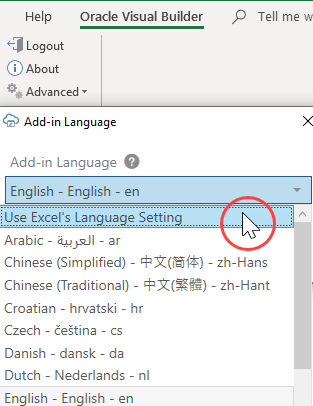15 Internationalization
Oracle Visual Builder Add-in for Excel is available in various languages. It automatically detects the user's preferred language from Microsoft Excel and uses that language where possible.
The date, date-time, and number formats used by the add-in are culture-sensitive. See also Appearance of an Integrated Excel Workbook.
- Labels visible on the Oracle Visual Builder ribbon and in various windows displayed by the add-in. These labels, known as the add-in labels, are owned by the add-in and are localized.
- Labels visible as column headers and field labels are known as business object field titles. These titles are owned by the REST service.

Description of the illustration excel-language.png
The add-in sends the accept-language header to the service on every request. The language setting specified for Excel is used for the add-in labels and for requests to the service, including the describe requests that fetches the initial business object field titles.
Note:
Because business object field titles are owned by the service, contact the service owner for any missing translations or languages.Change the Add-in's Language
You can change the language that the Excel add-in uses. Do this if you want to evaluate your integrated workbook with different languages.
- In Excel, click the Oracle Visual Builder tab.
- Choose Select Language from the Advanced drop-down.
- In the Add-in Language drop-down list that appears, select the language you want to use. The drop-down list displays the languages that the add-in supports.
- Click OK.
- Clear the embedded browser cache. See Clear the Embedded Browser Cache.
- Restart Excel to make your changes take effect.
The add-in's user interface elements (Download Data and so on) now use the language you selected. If the selected language uses a right-to-left writing system, the add-in's user interface elements appear in right-to-left mode. The language that Excel uses remains unchanged, as does the format used for dates, times, and numbers. See Excel or Windows options to change Excel’s language and formats for dates, times, and numbers. See also Natural Language Support.
The language that you choose for the add-in language is stored in a local file in the Windows user profile. You can select the Use Excel’s Language Setting option in the Add-in Language drop-down list to remove this setting for the current user.

Description of the illustration excel-choose-lang.png
Refresh All Field Titles
You can refresh all field titles in your integrated workbook if, for example, you want to display field titles in another language.
Imagine, an invoices workbook was configured and tested with English as the current language, so all field titles are in English and this information is saved with the workbook. Now imagine this workbook was sent to someone in France for data entry. That person has Windows and Excel configured for French, and she would like to see field titles in French as well. Resetting the field titles enables this data entry operator to see field titles in French.
When you refresh field titles, Oracle Visual Builder Add-in for Excel fetches the service description for each business object, if possible, and refreshes all of the business object's field titles. If a catalog has any business objects that are not used in a layout, the unused business objects are not refreshed. When it finishes, any affected layouts are redrawn automatically.
The add-in uses saved metadata path information to access the service description document. For older workbooks or catalogs with a service type of "other", the metadata path settings are empty. In this case, the add-in sets the metadata path to the default values for the service framework type before starting the refresh. These settings can be viewed from the General page of the Business Object Editor.
Before you begin, upload any pending changes to your workbook. If you don't, your pending changes will be discarded during the refresh.
Caution:
A reset wipes out any local changes made to field titles using the Business Object Field Editor.When the refresh is complete, the add-in displays the results of the refresh in the Status window.
If the add-in is unable to fetch the service description for a given business object, the business object is skipped and the details are logged. To troubleshoot the error, open the log console and repeat the process to discover the cause. See Logging Console.
If the error is caused by incorrect or missing path details, consult with the REST API owner and update the path information, including the base path and metadata path settings, as required. See Manage Metadata Path Information.
Note:
When the add-in fetches the service description from the metadata path, it includes the accept-language header as described in Natural Language Support. A given service may or may not have translations for the requested language. For any missing translations, contact the owner of the service.
Oracle REST Data Services (ORDS) do not provide localized service descriptions.